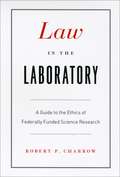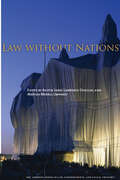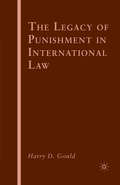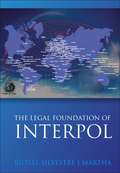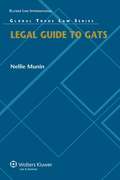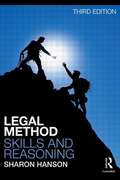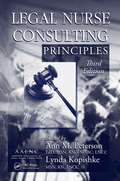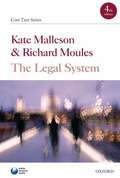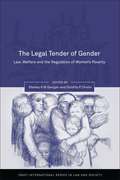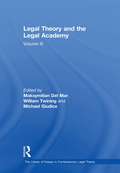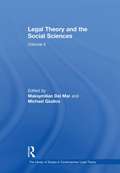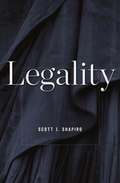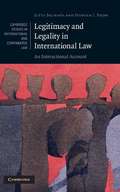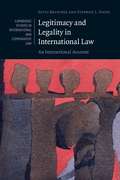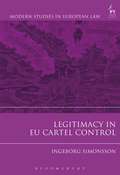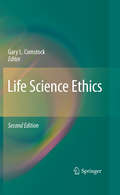- Table View
- List View
Law in the Laboratory: A Guide to the Ethics of Federally Funded Science Research
by Robert P. CharrowThe National Institutes of Health and the National Science Foundation together fund more than $40 billon of research annually in the United States and around the globe. These large public expenditures come with strings, including a complex set of laws and guidelines that regulate how scientists may use NIH and NSF funds, how federally funded research may be conducted, and who may have access to or own the product of the research. Until now, researchers have had little instruction on the nature of these laws and how they work. But now, with Robert P. Charrow’s Law in the Laboratory, they have a readable and entertaining introduction to the major ethical and legal considerations pertaining to research under the aegis of federal science funding. For any academic whose position is grant funded, or for any faculty involved in securing grants, this book will be an essential reference manual. And for those who want to learn how federal legislation and regulations affect laboratory research, Charrow’s primer will shed light on the often obscured intersection of government and science.
Law in the Laboratory: A Guide to the Ethics of Federally Funded Science Research
by Robert P. CharrowThe National Institutes of Health and the National Science Foundation together fund more than $40 billon of research annually in the United States and around the globe. These large public expenditures come with strings, including a complex set of laws and guidelines that regulate how scientists may use NIH and NSF funds, how federally funded research may be conducted, and who may have access to or own the product of the research. Until now, researchers have had little instruction on the nature of these laws and how they work. But now, with Robert P. Charrow’s Law in the Laboratory, they have a readable and entertaining introduction to the major ethical and legal considerations pertaining to research under the aegis of federal science funding. For any academic whose position is grant funded, or for any faculty involved in securing grants, this book will be an essential reference manual. And for those who want to learn how federal legislation and regulations affect laboratory research, Charrow’s primer will shed light on the often obscured intersection of government and science.
The Law of Corporate Finance: Volume II: Contracts in General
by Petri Mäntysaari1. 1 Investments, Generic Contracts, Payments According to Volume I, contracts are one of the five generic legal tools used to manage cash flow, risk, agency relationships, and information. Many investments are therefore based on one or more contracts. Obviously, the firm should draft good contracts. Good drafting can ensure the same intended cash flow with reduced risk. Bad drafting can increase risk. This volume attempts to deconstruct contracts used by non-financial firms and analyse them from a cash flow, risk, agency, and information perspective. The starting point is a generic contract, i. e. a contract which does not belong to any particular contract type (Chapters 2–7). This volume will also focus on payment obligations. Payment obligations are characteristic of all financial instruments, and they can range from simple payment obligations in minor sales contracts and traditional lending contracts (Chapters 8– 11). 1. 2 Particular Contract Types A number of particular contract types have been discussed in the other volumes of this book. (1) A certain party’s investment contract can be another party’s fu- ing contract. Particular investment contracts will therefore be discussed in Volume III in the context of funding. (2) Many contracts are necessary in the context of business acquisitions discussed in Volume III. (3) Multi-party contracts are c- mon in corporate finance. The firm’s contracts with two or more parties range from syndicated loans to central counterparties’ contracts. Such contracts will be discussed both in Chapter 12 and Volume III.
The Law of Corporate Finance: Volume III: Funding, Exit, Takeovers
by Petri Mäntysaari1.1 Cash Flow, Risk, Agency, Information, Investments The first volume dealt with the management of: cash flow (and the exchange of goods and services); risk; agency relationships; and information. The firm m- ages these aspects by legal tools and practices in the context of all commercial transactions. The second volume discussed investments. As voluntary contracts belong to the most important legal tools available to the firm, the second volume provided an - troduction to the general legal aspects of generic investment contracts and p- ment obligations. This volume discusses funding transactions, exit, and a particular category of decisions raising existential questions (business acquisitions). Transactions which can be regarded as funding transactions from the perspective of a firm raising the funding can be regarded as investment transactions from the perspective of an - vestor that provides the funding. Although the perspective chosen in this volume is that of a firm raising funding, this volume will simultaneously provide infor- tion about the legal aspects of many investment transactions. 1.2 Funding, Exit, Acquisitions Funding transactions are obviously an important way to manage cash flow. All - vestments will have to be funded in some way or another. The firm’s funding mix will also influence risk in many ways. Funding. The most important way to raise funding is through retained profits and by using existing assets more efficiently. The firm can also borrow money from a bank, or issue debt, equity, or mezzanine securities to a small group of - vestors.
The Law of MERCOSUR
by Marcilio Toscano Franca Filho Lucas Lixinski María Belén GiupponiThe Law of MERCOSUR presents both an overview and in-depth analysis of one of the world's most important and increasingly influential economic organisations. The book comprises both a series of first-hand analyses of MERCOSUR by experts from countries in the MERCOSUR bloc, and also discussions from other parts of the world looking at MERCOSUR as global actor of ever-increasing importance. The book is divided into three main parts: the first analyses the key institutional legal aspects of MERCOSUR, looking at its history, the general theory of economic integration, and basic aspects relating to the functioning of MERCOSUR; the second examines specialised topics, including the regulation of the environment, human rights and the energy market in MERCOSUR; and in the third part the editors offer a translation of core MERCOSUR instruments, with the objective of furthering understanding of the economic bloc. Original in its conception, the book aims to fill a major gap in the English-language literature by offering a comprehensive and in-depth analysis of the Law of MERCOSUR, and it is hoped that it will become essential reading for those practitioners and academics who are interested not only in MERCOSUR, but in economic integration generally, in international trade, and in the regional aspects of the phenomenon of globalisation.
Law without Nations (The Amherst Series in Law, Jurisprudence, and Social Thought)
by Austin Sarat Lawrence Douglas Martha Merrill UmphreyThe possibility of law in the absence of a nation would seem to strip law from its source of meaning and value. At the same time, law divorced from nations would clear the ground for a cosmopolitan vision in which the prejudices or idiosyncrasies of distinctive national traditions would give way to more universalist groundings for law. These alternately dystopian and utopian viewpoints inspire this original collection of essays on law without nations. This book examines the ways in which the growing internationalization of law affects domestic national law, the relationship between cosmopolitan legal ideas and understandings of national identity, and the intersections of identity and law based on the liberal tradition of jurisprudence and transnational influences. Ultimately, Law without Nations offers sharp analyses of the fraught relationship between the nation and the state—and the legal forms and practices that they require, constitute, and violently contest.
Lebenserhaltung als Haftungsgrund (MedR Schriftenreihe Medizinrecht)
by Petra BaltzIn der Arbeit wird untersucht, unter welchen Voraussetzungen die Erhaltung menschlichen Lebens Schadensersatzansprüche des Patienten begründet. Die Fragestellung ergibt sich aus dem Patientenrecht auf Selbstbestimmung, das auch die Ablehnung lebenserhaltender Maßnahmen regelt. Nach Darstellung der straf- und haftungsrechtlichen Grundlagen erläutert die Autorin, wer in welcher Situation über lebenserhaltende Maßnahmen zu entscheiden hat. Anhand verschiedener Fallkonstellationen wird geprüft, inwieweit diese Maßnahmen Schadensersatzansprüche auslösen.
The Legacy of Punishment in International Law
by H. GouldThis book explores the evolution of international punishment from a natural law-based ground for the use of force and conquest to a series of jurisdictional and disciplinary practices in international law not previously seen as being conceptually related.
The Legal Foundations of INTERPOL
by Rutsel Silvestre MarthaThis book is a study of the legal aspects of the birth and development of an international organisation, using the example of INTERPOL as a detailed case study. It is not a constitutional manual for INTERPOL, but an organisational study, and does not seek to be exhaustive in terms of its description of INTERPOL's operations. Its main focus is the examination of the question whether an international organisation, in this case INTERPOL, can be created without a solemn and formally celebrated treaty. At the same time the book sets out the legal foundations for extra-judicial international police enforcement cooperation and explains the creation, structure and operation of INTERPOL, the organisation that promotes that cooperation. For practitioners who, for whatever reason, have to deal with INTERPOL, it provides a much-needed explanation of the legal foundations of the Organisation, its legal status and some basic guidance on its operations. It also includes information relevant for lawyers litigating issues with INTERPOL about how their clients can challenge the way the Organisation has processed information concerning them, or has alerted police forces worldwide about them.The work is to be welcomed not only because of its thorough research and main conclusions, but primarily because it submits known facts about INTERPOL to a rigorous legal analysis from the perspective of public international law…The practical, as well as theoretical importance of the study needs to be underlined. The study provides practitioners who for whatever reason have to deal with INTERPOL, with the much needed explanation about the legal foundation of the Organisation, its legal status and some basic guidance on its operations.Foreword by Ronald K Noble, Secretary General of INTERPOL, July 2009
Legal Guide to GATS
by Nellie MuninThis academically rigorous yet highly accessible book guides the reader through an ocean of literature and interpretative possibilities embodied in GATS. In doing so, it provides a road map of the various interpretative possibilities and dilemmas posed by the treaty. The work advances a legal analysis of GATS, based on its historical and institutional roots, while at the same time taking into account its objectives and prospects, as well as the balance of interests involved. In total, this timely book presents a thorough legal analysis of GATS that will serve as a comprehensive yet highly useful guide to the agreement.
Legal Method Essentials (Edinburgh Law Essentials)
by Dale McFadzean Gareth RyanLegal Method Essentials is an invaluable study guide for students. It provides up-to-date, concise and comprehensive coverage of Legal Method and is the ideal text for students who come new to the subject and for those preparing for exams. This book is also an excellent resource for those who need to refresh or update their knowledge.
Legal Method, Skills and Reasoning
by Sharon HansonWritten to provide an integrated teaching tool for courses in legal method, this book encourages debate and critical thinking in new students.
Legal Nurse Consulting Principles
by Lars Harms-Ringdahl Ann M. Peterson Lynda KopishkeOver the past generation, the practice of legal nurse consulting has grown to include areas such as life care planning, risk management, and administrative law, as well as taking on a more diversified role in both criminal and civil law and courtroom proceedings. First published in 1997, Legal Nurse Consulting, Principles and Practices provided pro
The Legal System: (PDF) (Core Texts Ser.)
by Kate Malleson Richard MoulesThe Legal System provides an overview of the institutions, personnel, and procedures that make up the legal system in England and Wales. Current changes are explained and critically evaluated, and the text explores a number of key competing themes and underlying tensions which run through the legal system. These are identified in the first chapter and then illustrated through concise exposition and practical examples in the following substantive chapters. Brief summaries at the beginning of each chapter enable students to assess the key points of study quickly and easily. Meanwhile further reading lists, useful web site links, and self-test questions at the end of chapters allow students to research the subject in more depth, and to test their understanding of this important area of study. This is an ideal introduction to the subject; the concise volume successfully combines key principles with thought-provoking questions, and points the way for further study and more in-depth analysis.
The Legal Tender of Gender: Law, Welfare and the Regulation of Women's Poverty (Oñati International Series in Law and Society)
by Shelley A. Gavigan Dorothy E ChunnExtensive welfare, law and policy reforms characterised the making and unmaking of Keynesian states in the twentieth century. This collection highlights the gendered nature of these regulatory shifts and, specifically, the roles played by women as reformers, welfare workers and welfare recipients, in the development of welfare states historically. The contributors are leading feminist socio-legal scholars from a range of disciplines in Canada, the United States and Israel. Collectively, their analyses of women, law and poverty speak to long-standing and ongoing feminist concerns: the importance of historically informed research, the relevance of women's agency and resistance to the experience of inequality and injustice, the specificity of the experience of poor women and poor mothers, the implications of changes to social policy, and the possibilities for social change. Such analyses are particularly timely as the devastation of neo-liberalism becomes increasingly obvious. The current world crisis of capitalism is a defining moment for liberal states – a global catastrophe that concomitantly creates a window of opportunity for critical scholars and activists to reframe debates about social welfare, work, and equality, and to reinsert the discourse of social justice into the public consciousness and political agendae of liberal democracies.
Legal Theory and the Legal Academy: Volume III
by MaksymilianDel MarThe third in a series of three volumes on Contemporary Legal Theory, this volume deals with four topics: 1) the role of legal theory in the legal curriculum; 2) the teaching of legal theory; 3) the relationship of legal theory to legal scholarship; and 4) the relationship of legal theory to comparative law. The focus of the first two topics is on the common law world, where the debates over the aims and proper place of legal theory in the study of law have traversed a good deal of ground since John Austin's 1828 lecture, 'The Uses and the Study of Jurisprudence.' These first two parts offer a selection of the most important papers, including surveys, as well as pedagogical viewpoints and particular course descriptions from analytical, critical, feminist, law-and-literature and global perspectives. The last three decades have seen just as many changes for legal scholarship and comparative law. These changes (such as the rise of empirical legal scholarship) have often attracted the attention of legal theorists. Within comparative law, the last thirty years have witnessed intense methodological reflection within the discipline; the results of these reflections are themselves properly recognised as legal theoretical contributions. The volume collects the key papers, including those by Neil MacCormick, Mark Van Hoecke, Andrew Halpin, William Ewald and Geoffrey Samuel.
Legal Theory and the Legal Academy: Volume III
by MaksymilianDel MarThe third in a series of three volumes on Contemporary Legal Theory, this volume deals with four topics: 1) the role of legal theory in the legal curriculum; 2) the teaching of legal theory; 3) the relationship of legal theory to legal scholarship; and 4) the relationship of legal theory to comparative law. The focus of the first two topics is on the common law world, where the debates over the aims and proper place of legal theory in the study of law have traversed a good deal of ground since John Austin's 1828 lecture, 'The Uses and the Study of Jurisprudence.' These first two parts offer a selection of the most important papers, including surveys, as well as pedagogical viewpoints and particular course descriptions from analytical, critical, feminist, law-and-literature and global perspectives. The last three decades have seen just as many changes for legal scholarship and comparative law. These changes (such as the rise of empirical legal scholarship) have often attracted the attention of legal theorists. Within comparative law, the last thirty years have witnessed intense methodological reflection within the discipline; the results of these reflections are themselves properly recognised as legal theoretical contributions. The volume collects the key papers, including those by Neil MacCormick, Mark Van Hoecke, Andrew Halpin, William Ewald and Geoffrey Samuel.
Legal Theory and the Social Sciences: Volume II
by MaksymilianDel MarEver since H.L.A. Hart's self-description of The Concept of Law as an 'exercise in descriptive sociology', contemporary legal theorists have been debating the relationship between legal theory and sociology, and between legal theory and social science more generally. There have been some who have insisted on a clear divide between legal theory and the social sciences, citing fundamental methodological differences. Others have attempted to bridge gaps, revealing common challenges and similar objects of inquiry. Collecting the work of authors such as Martin Krygier, David Nelken, Brian Tamanaha, Lewis Kornhauser, Gunther Teubner and Nicola Lacey, this volume - the second in a three volume series - provides an overview of the major developments in the last thirty years. The volume is divided into three sections, each discussing an aspect of the relationship of legal theory and the social sciences: 1) methodological disputes and collaboration; 2) common problems, especially as they concern different modes of explanation of social behaviour; and 3) common objects, including, most prominently, the study of language in its social context and normative pluralism.
Legal Theory and the Social Sciences: Volume II
by MaksymilianDel MarEver since H.L.A. Hart's self-description of The Concept of Law as an 'exercise in descriptive sociology', contemporary legal theorists have been debating the relationship between legal theory and sociology, and between legal theory and social science more generally. There have been some who have insisted on a clear divide between legal theory and the social sciences, citing fundamental methodological differences. Others have attempted to bridge gaps, revealing common challenges and similar objects of inquiry. Collecting the work of authors such as Martin Krygier, David Nelken, Brian Tamanaha, Lewis Kornhauser, Gunther Teubner and Nicola Lacey, this volume - the second in a three volume series - provides an overview of the major developments in the last thirty years. The volume is divided into three sections, each discussing an aspect of the relationship of legal theory and the social sciences: 1) methodological disputes and collaboration; 2) common problems, especially as they concern different modes of explanation of social behaviour; and 3) common objects, including, most prominently, the study of language in its social context and normative pluralism.
Legality
by Scott J. ShapiroLegality is a profound work in analytical jurisprudence, the branch of legal philosophy which deals with metaphysical questions about the law. In the twentieth century, there have been two major approaches to the nature of law. The first and most prominent is legal positivism, which draws a sharp distinction between law as it is and law as it might be or ought to be. The second are theories that view law as embedded in a moral framework. Scott Shapiro is a positivist, but one who tries to bridge the differences between the two approaches. In Legality, he shows how law can be thought of as a set of plans to achieve complex human goals. His new “planning” theory of law is a way to solve the “possibility problem”, which is the problem of how law can be authoritative without referring to higher laws.
Legitimacy And Legality In International Law: An Interactional Account (PDF)
by Jutta Brunnée Stephen J. ToopeIt has never been more important to understand how international law enables and constrains international politics. By drawing together the legal theory of Lon Fuller and the insights of constructivist international relations scholars, this book articulates a pragmatic view of how international obligation is created and maintained. First, legal norms can only arise in the context of social norms based on shared understandings. Second, internal features of law, or 'criteria of legality', are crucial to law's ability to promote adherence, to inspire 'fidelity'. Third, legal norms are built, maintained or destroyed through a continuing practice of legality. Through case studies of the climate change regime, the anti-torture norm, and the prohibition on the use of force, it is shown that these three elements produce a distinctive legal legitimacy and a sense of commitment among those to whom law is addressed.
Legitimacy And Legality In International Law: An Interactional Account (PDF)
by Stephen J. Toope Jutta BrunnéeIt has never been more important to understand how international law enables and constrains international politics. By drawing together the legal theory of Lon Fuller and the insights of constructivist international relations scholars, this book articulates a pragmatic view of how international obligation is created and maintained. First, legal norms can only arise in the context of social norms based on shared understandings. Second, internal features of law, or 'criteria of legality', are crucial to law's ability to promote adherence, to inspire 'fidelity'. Third, legal norms are built, maintained or destroyed through a continuing practice of legality. Through case studies of the climate change regime, the anti-torture norm, and the prohibition on the use of force, it is shown that these three elements produce a distinctive legal legitimacy and a sense of commitment among those to whom law is addressed.
Legitimacy in EU Cartel Control (Modern Studies in European Law)
by Ingeborg SimonssonThis book examines the law developed by the EU to control cartels. The law, including case-law, is carefully documented and analysed against a standard oflegitimacy which questions the EU's enforcement measures, its institutional structures, policy choices, substantive law, evidentiary standards and procedures and sanctions. It includes a unique catalogue of over 150 EU cartel decisions, as well as novel analyses of difficult borderline issues such as mixed horizontal and vertical cartels, single-brand dealer cartels and buyer cartels. The effect on trade in cartel cases is analysed with reference to established law and deterrence theory. Throughout the book the author asks whether EU law also applies at the national level, or whether certain assessments need to be made according to national law. This approach makes the book particularly helpful for national authorities, courts and private practitioners. The book includes in-depth comparisons with US law as well as a comprehensive survey of the secondary (academic) literature on cartels. As such it presents not only a comprehensive practical view, but also a sound theoretical framework for better understanding cartel law. This is a work which will be of utmost importance to those working in competition authorities and competition courts in the EU Member States, as well as those working for EU institutions and in private practice and academia.
Life Science Ethics
by Gary L. ComstockDoes nature have intrinsic value? Should we be doing more to save wilderness and ocean ecosystems? What are our duties to future generations of humans? Do animals have rights? This revised edition of "Life Science Ethics" introduces these questions using narrative case studies on genetically modified foods, use of animals in research, nanotechnology, and global climate change, and then explores them in detail using essays written by nationally-recognized experts in the ethics field. Part I introduces ethics, the relationship of religion to ethics, how we assess ethical arguments, and a method ethicists use to reason about ethical theories. Part II demonstrates the relevance of ethical reasoning to the environment, land, farms, food, biotechnology, genetically modified foods, animals in agriculture and research, climate change, and nanotechnology. Part III presents case studies for the topics found in Part II.
